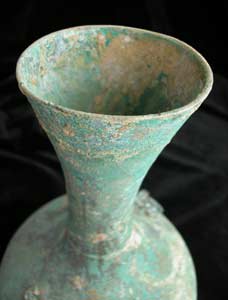Han Long-Necked Bronze Hu, 206 BCE - 220 CE
Bronze
13.25
H.862
Further images
This long-necked bronze hu is notable for its elegant simplicity. Such a vessel would have functioned as a container of sumptuous wines. This refined hu is essentially unadorned, save for...
This long-necked bronze hu is notable for its elegant simplicity. Such a vessel would have functioned as a container of sumptuous wines. This refined hu is essentially unadorned, save for two decorative Tao Tieh mask handles that have been attached to the shoulder of the swollen belly. These stylized animal heads represent a type of dragon found in Chinese mythology. Their abstracted representation demonstrates the influence of previous styles, such as the Zhou Dynasty, on the art of the Han. Originally, a lid would have capped this hu; however, it has long since vanished. Over the ages, the bronze has acquired a fabulous patina of alternating green and burgundy hues, adding both delightful colors and pleasing textures to the work. Forged from bronze, this hu would have been the treasured possession of an elite member of the Han Dynasty social hierarchy. Quite simply, only a court nobility of wealthy merchants could afford such a luxury. Although this vessel would have functioned as a wine container in life, it was found discovered buried in a tomb. A symbol for the bountiful pleasures of life, for drinking and feasting, this hu would have represented the joys to be experienced in the afterlife and the feasts and celebrations yet to come. Today, this vessel is not only a gorgeous work of art, treasured for its history and rarity; but also a stunning reminder of the richness and luxury of the Han Dynasty, both in this world and the next





